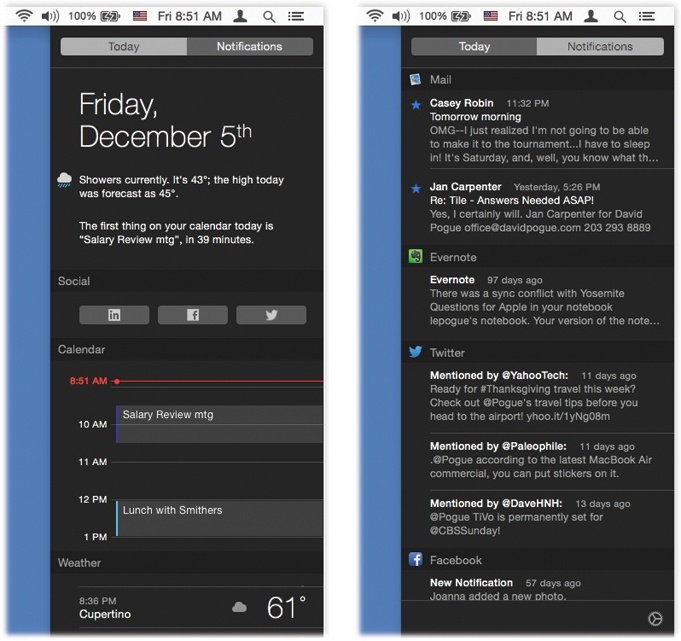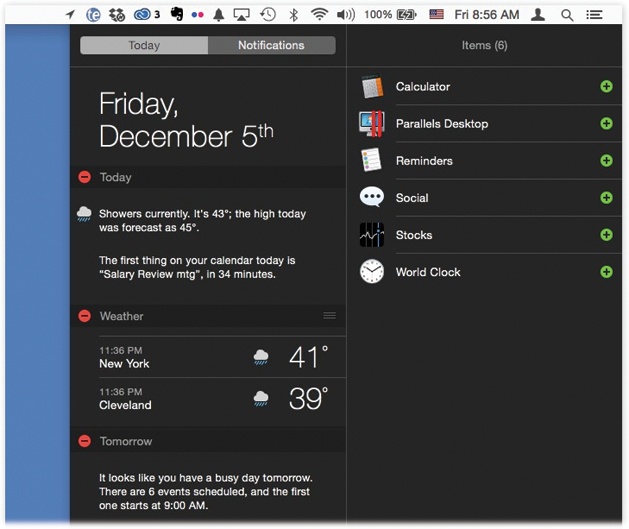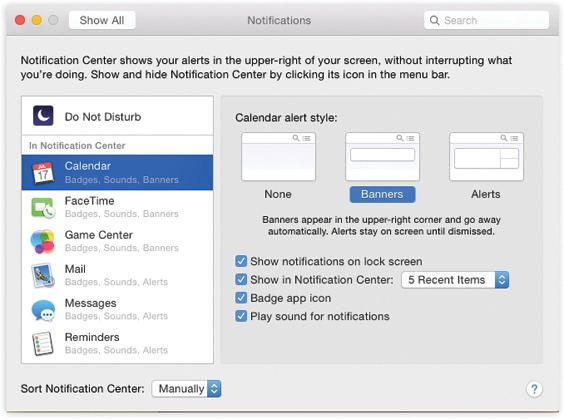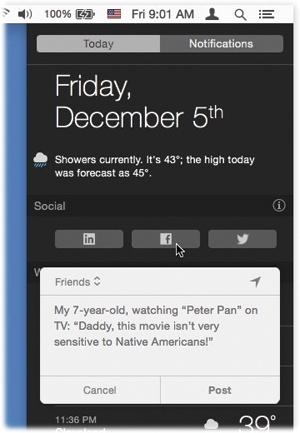All right, now you know how to dismiss, stifle, or respond to notification bubbles. But what if you miss one? Or you decide to act on it later?
Thought you’d never ask.
All of those “Hey you!” messages collect on a single screen called the Notification Center (Figure 9-3).
To make it appear on a laptop, swipe two fingers onto the trackpad from the right. (Start the swipe off to the right of the trackpad. It’s the first time you’ve ever crossed the edge of the trackpad with a Mac gesture. Weird.)
Figure 9-3. Right: Here’s the Notification Center, where all those incoming messages pile up, for your inspection pleasure. Left: The Today view shows everything you’ve got coming up—as well as the information widgets you’ve installed here (page 340).
You can also open the Notification Center by clicking the  in the upper-right corner of your screen. That’s a handy trick if your Mac doesn’t have a trackpad—if it’s an iMac, for example. (You can also set up a keystroke or a “hot corner” to open the Notification Center, if you like. See Changing a Menu Keyboard Shortcut and Screen corners.)
in the upper-right corner of your screen. That’s a handy trick if your Mac doesn’t have a trackpad—if it’s an iMac, for example. (You can also set up a keystroke or a “hot corner” to open the Notification Center, if you like. See Changing a Menu Keyboard Shortcut and Screen corners.)
Either way, the Notification Center slides onto the screen like a classy black window shade, printed in white with every recent item of interest; whatever was on your screen gets shoved temporarily off to the left side.
Tip
To close the Notification Center, swipe the opposite way (left to right) with two fingers. Or just click any other part of the screen. Or click the  again. Or press the Esc key. Or just blink really hard.
again. Or press the Esc key. Or just blink really hard.
The Notification Center has two tabs at the top (Figure 9-3):
Today. On the Today tab (Figure 9-4), you see today’s weather, all your upcoming appointments and reminders, and an assortment of widgets (calculator, stock report, news headlines) that you’ve installed there. More on this in a moment.
Figure 9-4. Editing the widgets of the Today list is simple enough. The left column represents what’s in the Today list now; the right column lists widgets that aren’t installed at the moment. Click
 to remove a widget from the Today list, or tap
to remove a widget from the Today list, or tap  to add a module. Drag the
to add a module. Drag the  up or down to move it higher or lower in the list. Then tap Done.
up or down to move it higher or lower in the list. Then tap Done.Notifications. This tab lists all your apps’ notifications, as well as all of your Mac’s messages, reminders, upcoming appointments, and so on.
Each produces a scrolling panel; read on.
The Today panel presents an executive summary of everything you need to know today, in plain English: your upcoming appointments (“ ‘Personnel meeting’ is next up on your calendar, at 2 PM”); reminders coming due; weather and stock information; and a preview of your schedule tomorrow. It’s identical to the Today panel on the iPhone or iPad, if you’re scoring at home.
Intriguingly, Apple also allows apps to add their own sections to the Today list.
For example, Dropbox can show a list of files that have been added to your Dropbox folder; Evernote can add buttons for creating new notes or reminders; The New York Times, Yahoo Digest, and Huffington Post apps can add headlines; the Kindle app offers links to the books you’re reading right now; and so on. El Capitan comes with a new one of its own, too: Find My Friends, which lets you see on a map where your loved ones are. (This presumes, of course, that they have iPhones and have permitted you to track them.)
Each of these modules is called a widget, and there are tons of them available. To manage all of this, click Edit at the bottom of the panel; proceed as described in Figure 9-4.
On the Notifications tab (Figure 9-3, right), you can have two kinds of fun:
Click an item to open the relevant app for more details. For example, click an appointment listed there to open its information panel in Calendar. Click the name of a software update to open the Mac App Store program to read about it and download it. Click a message’s name to open Mail, where you can read the entire message.
Click the little
 to dismiss one day’s entire list of notifications—or one app’s worth—once you’ve seen them. (The
to dismiss one day’s entire list of notifications—or one app’s worth—once you’ve seen them. (The  appears when you point to a notification.)
appears when you point to a notification.)So which is it—all the notifications from one app? Or from one day? That’s up to you. It depends on how you’ve set things up in System Preferences→Notifications, as described in the next section. For example, if you’ve chosen to sort your notifications by Recents, then the
 button deletes a day of notifications; if you’ve chosen Recents by App, it deletes all the notifications from a particular app.
button deletes a day of notifications; if you’ve chosen Recents by App, it deletes all the notifications from a particular app.
You can (and should) specify which apps are allowed to junk up your Notification Center. Open System Preferences→Notifications to see the list of apps that might want to get your attention in the master Notifications list (Figure 9-5).
Tip
A faster way to get to the proper System Preferences pane is built right into the Notification Center itself. Click the tiny  icon at the very bottom of the panel.
icon at the very bottom of the panel.
This is also the place where you can specify the order of the various apps’ notifications in the center. Use the Sort Notification Center pop-up menu at the bottom of the window.
If you choose Recents, then the apps with the newest alerts appear at the top. If you choose Recents by App, the notifications are grouped under headings that correspond to the app generating them. And if you tap Manually by App, you can simply drag the app names up or down in the list to specify their top-to-bottom order on the Notification Center list.
Out of the box, a lot of OS X programs are listed in the Notification Center. Here are some of the most significant:
Facebook governs the appearance of updates from your Facebook friends.
FaceTime tells you when you’ve missed an incoming call.
Figure 9-5. Here in System Preferences, you can specify which apps are permitted to intrude on the precious billboard that is your Notification Center—and how they’re permitted to intrude. Some individual apps, including Mail and Calendar, offer additional controls in their Preferences boxes. For example, in Calendar, you can turn off notifications from shared calendars and from meeting invitations.
Family informs you when someone on your iCloud family-sharing plan (Family Sharing) has been up to something.
Game Center flags you when somebody has invited you to a game or wants to become your friend.
iCloud Photos updates you when someone has subscribed to a stream of pictures you’ve shared, or has commented on one, or added one. See iCloud Photo Sharing for more on this feature.
Mail lets you know when you’ve received a new message. You can also specify whether or not the notification displays the beginning of the message itself when you’re not seated at your Mac, which you may consider to be either useful or a scary privacy violation. (Mercifully, Mail’s Preferences→General tab lets you limit these alerts, so you won’t be buried in a barrage of meaningless heads-up bubbles. You can tell Mail to alert you only when somebody in your Contacts list has written to you, only when a message lands in a smart mailbox folder, only when you get email from someone you’ve designated as a VIP—or whenever any message lands in any mailbox.)
Messages lets you know when somebody has sent you an instant message.
Safari. Certain websites, if they’re open in Safari, can send you notifications (known as HTML web notifications).
Twitter pops up whenever somebody has mentioned you on Twitter or tried to reach you with a direct message.
Tip
If you click Notifications, you can limit Twitter so that you’re alerted only when someone sends you a Direct Message (person-to-person tweet), or when you hear from someone you follow.
Other companies’ apps may appear in this list, too: BusyCal, Evernote, Skype, and so on.
Now it’s time to change the settings for one app at a time. Click an app’s name to see its individual Notifications settings (Figure 9-5—the Calendar app, in this example).
For example, as hinted above, different apps can get your attention in different ways:
None. If certain apps seem to bug you with news you really don’t care about, you can make them shut up forever. They won’t bother you with pop-up messages, although they can still insert items into the Notification Center panel.
Banners. This option (Figure 9-5) makes incoming notifications slide quietly and briefly onto the top right of your screen. Each message holds still long enough for you to read it, but it goes away automatically after a few seconds. Banners are a good option for things like Facebook and Twitter updates and incoming email messages.
Alerts. These notifications don’t go away until you click a button to dismiss them. Good for important messages, like alarms and flight updates.
At the bottom of the Notifications window, you get more settings for each app:
Show notifications on lock screen. Do you want summaries of all your missed notifications to appear on your Lock screen (“5 email notifications”) when you wake the Mac after having been away? It’s a great feature, as long as you don’t mind passing busybodies knowing how popular you are.
Show in Notification Center: __ Recent Items. This pop-up menu specifies how many rows of information you want to reserve for this app in the Notification Center: one from your Scrabble app, for example, but all 20 of your recent Reminders.
Tip
If you turn off this checkbox, the app disappears from the Notification Center completely. You can still get its alert messages, but you won’t see them listed in the Notification Center panel. Another way to achieve the same effect: Drag the app’s name down to the bottom of the list, below the Not in the Notification Center heading.
Badge app icon. If you turn this option on, then each app’s actual icon (in your Launchpad and on your Dock) sprouts a red, circled number. This number lets you know how many times it’s tried to flag you about something.
Play sound for notifications. Some apps play a sound when a new notification arrives. For example, Calendar dings to remind you of an upcoming event. It’s a little extra insurance that you won’t miss a nudge, but here’s where you can turn these sounds off.
When you visit the customizing screen shown in Figure 9-5, you see the widgets available to install onto your Today tab. One of them, Social, is worth special note. If you install it onto your Today tab, you get, at the top, buttons that let you send a Messages or LinkedIn message, post a tweet, or post a Facebook item (Figure 9-6). Now such posts are available right from there, without your having to open an app or go to a web page.
Figure 9-6. To send a tweet or a message (Facebook, LinkedIn, Messages), click the corresponding icon in the Today panel. Type your message; click Post or Send. (If you haven’t yet told OS X your name and password for that account, you have the chance to do that now.) If you’re sending a Facebook message, you can use the pop-up menus to specify which audience sees this note (friends, everyone, and so on), and whether or not you’d like your current geographical location to be included.
When you click one of these buttons, you get the little pop-up card illustrated in Figure 9-6.
And what do these buttons have to do with notifications? Absolutely nothing. They’re here in the Notification Center because Apple wanted them to be available anytime, anywhere, no matter what program you’re using—and the Notification Center is a perfect always-available dashboard.



